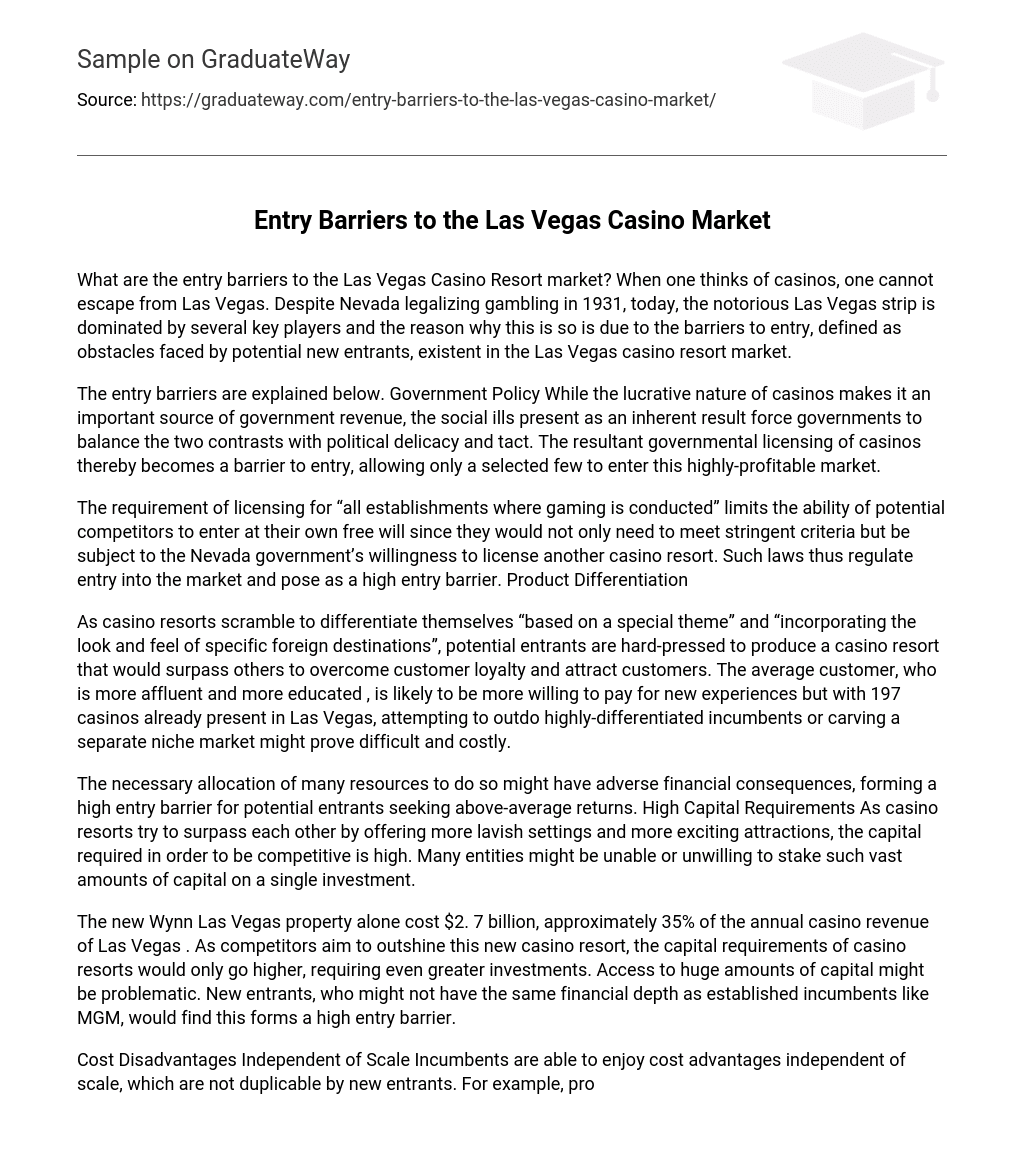What are the entry barriers to the Las Vegas Casino Resort market? When one thinks of casinos, one cannot escape from Las Vegas. Despite Nevada legalizing gambling in 1931, today, the notorious Las Vegas strip is dominated by several key players and the reason why this is so is due to the barriers to entry, defined as obstacles faced by potential new entrants, existent in the Las Vegas casino resort market.
The entry barriers are explained below. Government Policy While the lucrative nature of casinos makes it an important source of government revenue, the social ills present as an inherent result force governments to balance the two contrasts with political delicacy and tact. The resultant governmental licensing of casinos thereby becomes a barrier to entry, allowing only a selected few to enter this highly-profitable market.
The requirement of licensing for “all establishments where gaming is conducted” limits the ability of potential competitors to enter at their own free will since they would not only need to meet stringent criteria but be subject to the Nevada government’s willingness to license another casino resort. Such laws thus regulate entry into the market and pose as a high entry barrier. Product Differentiation
As casino resorts scramble to differentiate themselves “based on a special theme” and “incorporating the look and feel of specific foreign destinations”, potential entrants are hard-pressed to produce a casino resort that would surpass others to overcome customer loyalty and attract customers. The average customer, who is more affluent and more educated , is likely to be more willing to pay for new experiences but with 197 casinos already present in Las Vegas, attempting to outdo highly-differentiated incumbents or carving a separate niche market might prove difficult and costly.
The necessary allocation of many resources to do so might have adverse financial consequences, forming a high entry barrier for potential entrants seeking above-average returns. High Capital Requirements As casino resorts try to surpass each other by offering more lavish settings and more exciting attractions, the capital required in order to be competitive is high. Many entities might be unable or unwilling to stake such vast amounts of capital on a single investment.
The new Wynn Las Vegas property alone cost $2. 7 billion, approximately 35% of the annual casino revenue of Las Vegas . As competitors aim to outshine this new casino resort, the capital requirements of casino resorts would only go higher, requiring even greater investments. Access to huge amounts of capital might be problematic. New entrants, who might not have the same financial depth as established incumbents like MGM, would find this forms a high entry barrier.
Cost Disadvantages Independent of Scale Incumbents are able to enjoy cost advantages independent of scale, which are not duplicable by new entrants. For example, property prices in the Las Vegas strip have been steadily increasing at huge rates . Incumbents enjoy a first mover advantage, having invested when property prices were lower. Furthermore, more resources would also have to be spent to obtain relevantly-skilled staff, who are crucial to the success of the new entrants.
New entrants would thus find their start-up costs to be much higher than incumbents and the additional resources needed to compete reduce the lucrativeness of the investment, forming a high entry barrier where entrance is driven by the desire to earn above-average returns. High Customer Switching Costs Technology has allowed incumbents like Harrah’s, to apply tools such as data-mining extensive customer information collated from years of operations to help them implement strategies that increase customer switching costs, such as more effective customer loyalty programmes.
Given an individual’s loss aversion as highlighted in the prospect theory, customers are more unwilling to give up what they already have-accumulated privileges, and this creates high customer switching costs. The necessity to expend resources to overcome this customer loyalty makes it more difficult for potential competitors to earn above-average returns, thus forming a high entry barrier. Economies of Scale As incumbents expand through mergers and acquisitions to optimize capacity, they are likely also to experience higher economies of scale that drive down costs.
These economies of scale include deals with suppliers on the pretext of larger volumes and access to more resources such as skilled staff, which reduce costs. New entrants are unable to enjoy such economies of scale, translating into lower profits, thus creating an entry barrier. Additionally, as incumbents expand to capture different segments of the market, customer switching costs increase further since accumulated privileges can now be earned and utilized at a wider variety of casino resorts across different market segments.





